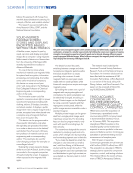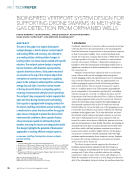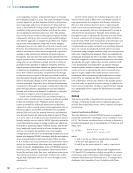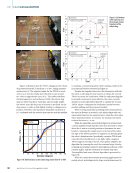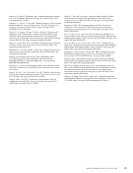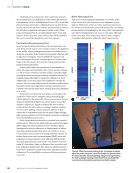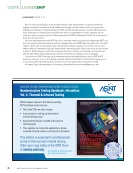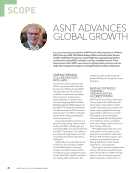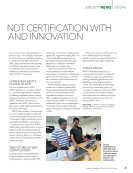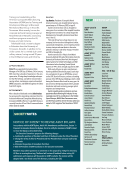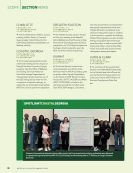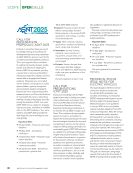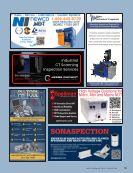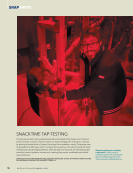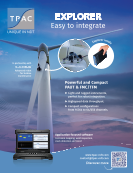survival [2, 3, 4]. Much research focuses
on drawing inspiration from the remark-
able evolutionary strategies employed
by the sensing mechanisms of biologi-
cal systems for survival and adaptation
across the natural world [5, 6]. Over
millennia, these organisms have devel-
oped an array of senses such as olfaction
(smell), gustation (taste), tactile (touch),
vision (sight) [5], and audition (hearing)
[2, 7, 8] each serving a unique purpose
and complementing one another to
enhance their adaptation to the specific
environments in which they operate.
Combining sensing and robotic inspira-
tion can substantially enhance the devel-
opment of mechanical systems, enabling
them to perform specialized tasks more
autonomously [9].
1.2. Mobility, Control, and
Autonomy
The most obvious aspect of bioinspira-
tion research is related to the develop-
ment of robotic platforms that replicate
natural movements and processes in
their mobility [10, 11]. From insects [12] to
mammals [13, 14], whether on land [15],
in water [1, 16, 17, 18], or in the air [19,
20, 21], evolution has led to remarkable
mobility adaptations and energy effi-
ciency across the animal kingdom. These
adaptations have inspired numerous
innovative approaches in robotics, par-
ticularly in the areas of motion, mobility
[1], and control strategies [10, 22] and
autonomous systems [23, 24] derived
from biological systems.
1.3. Materials and Structures
Bioinspired materials replicate the
properties or functions of natural mate-
rials using synthetic substances [25].
Bioinspiration in materials has already
been revolutionized by emerging man-
ufacturing technologies [25], such as
additive manufacturing, which facilitate
novel design concepts for applications
in sectors like aerospace [26]. From
the material level to the structure and
architectural level, this methodology
has transformed the way we design
and manufacture new components.
These components are characterized
by a high strength-to-weight ratio and
multifunctional capabilities, paving the
way for advancements in both perfor-
mance and efficiency [27].
2. Bioinspired Nondestructive
Testing/Evaluation
Inspiration from biological systems has
generally been applied to the broad
three categories mentioned, but it has
rarely been explored in more specific,
mission-oriented domains such as
NDT/E. While one might argue that
NDT/E methods can fall under the
broader field of sensing—where sensors
are used to indirectly gather information
from materials and structures without
impairing their functionality—our
approach differs. The key distinction is
that NDT/E is not just sensing it is a
comprehensive process. This process
involves multiple steps, including sensing,
the use of specialized materials in the
hardware, implementation (whether
manual or automated, such as through
robotics), preparation, calibration, and,
finally, interpretation of the data. The
ultimate goals—detection, localization,
diagnosis, and potentially prognosis—
are all integral parts of NDT/E methods.
We aim to learn the entire process from
biological systems that perform similar
tasks, not just individual components. In
this sense, we seek to understand bio-
logical processes that, in an abstract way,
align with the objectives of NDT/E goals.
These systems detect cavities (analogous
to defects in our mission), characterize
material properties such as dampness or
dryness (similar to modulus of elasticity),
and measure thickness (akin to corrosion
inspection)—functions directly relevant
to NDT/E.
To better explore the concept of
bioinspired NDT/E, let’s examine three
unique biological systems belonging
to a specialized category we refer to as
“nature’s NDE specialists”—aye-ayes,
termites, and red/arctic foxes—that
perform tasks similar to NDT/E.
2.1. Nature’s NDE Specialist #1:
Aye-Ayes
The aye-aye (Daubentonia madagas-
cariensis) is one of the most unique
primates in the world, first documented
on the island of Madagascar around
1780 [28]. This species represents a
remarkable evolutionary lineage that has
persisted for over 50 million years [29]
(see Figure 2).
The aye-aye, the world’s largest
nocturnal primate, is a relatively small
mammal, measuring an average of
80 cm from nose to tail and weighing
between 2.5 to 3 kg. It also has a notably
large brain (larger than other pro-
simians) [30] and the largest pinnae
(ears) among all primates [31]. The
aye-aye is best known for its remark-
able acoustic-based foraging behavior,
known as “tap-scanning” or “percus-
sive foraging” [32]. As it moves along a
tree’s surface, the aye-aye taps the wood
with its distinctive middle finger while
positioning its nose close to the tree
and angling its large, cupped pinnae
forward. These unique morphologi-
cal traits in its auditory sensory and
movement systems enable the aye-aye
to access food resources such as larvae
in cavities unavailable to most other
animals in Madagascar [33]. This evolu-
tionary success is attributed to the aye-
aye’s advanced movement coordination
and its specialized foraging technique,
which involves acoustic-based actuation
and sensing, synchronized with sensor
data fusion and learning capabilities.
Figure 2. The aye-aye (Daubentonia
madagascariensis).
A P R I L 2 0 2 5 • M AT E R I A L S E V A L U AT I O N 29
CREDIT:
DAVID
HARING,
DUKE
LEMUR
CENTER
on drawing inspiration from the remark-
able evolutionary strategies employed
by the sensing mechanisms of biologi-
cal systems for survival and adaptation
across the natural world [5, 6]. Over
millennia, these organisms have devel-
oped an array of senses such as olfaction
(smell), gustation (taste), tactile (touch),
vision (sight) [5], and audition (hearing)
[2, 7, 8] each serving a unique purpose
and complementing one another to
enhance their adaptation to the specific
environments in which they operate.
Combining sensing and robotic inspira-
tion can substantially enhance the devel-
opment of mechanical systems, enabling
them to perform specialized tasks more
autonomously [9].
1.2. Mobility, Control, and
Autonomy
The most obvious aspect of bioinspira-
tion research is related to the develop-
ment of robotic platforms that replicate
natural movements and processes in
their mobility [10, 11]. From insects [12] to
mammals [13, 14], whether on land [15],
in water [1, 16, 17, 18], or in the air [19,
20, 21], evolution has led to remarkable
mobility adaptations and energy effi-
ciency across the animal kingdom. These
adaptations have inspired numerous
innovative approaches in robotics, par-
ticularly in the areas of motion, mobility
[1], and control strategies [10, 22] and
autonomous systems [23, 24] derived
from biological systems.
1.3. Materials and Structures
Bioinspired materials replicate the
properties or functions of natural mate-
rials using synthetic substances [25].
Bioinspiration in materials has already
been revolutionized by emerging man-
ufacturing technologies [25], such as
additive manufacturing, which facilitate
novel design concepts for applications
in sectors like aerospace [26]. From
the material level to the structure and
architectural level, this methodology
has transformed the way we design
and manufacture new components.
These components are characterized
by a high strength-to-weight ratio and
multifunctional capabilities, paving the
way for advancements in both perfor-
mance and efficiency [27].
2. Bioinspired Nondestructive
Testing/Evaluation
Inspiration from biological systems has
generally been applied to the broad
three categories mentioned, but it has
rarely been explored in more specific,
mission-oriented domains such as
NDT/E. While one might argue that
NDT/E methods can fall under the
broader field of sensing—where sensors
are used to indirectly gather information
from materials and structures without
impairing their functionality—our
approach differs. The key distinction is
that NDT/E is not just sensing it is a
comprehensive process. This process
involves multiple steps, including sensing,
the use of specialized materials in the
hardware, implementation (whether
manual or automated, such as through
robotics), preparation, calibration, and,
finally, interpretation of the data. The
ultimate goals—detection, localization,
diagnosis, and potentially prognosis—
are all integral parts of NDT/E methods.
We aim to learn the entire process from
biological systems that perform similar
tasks, not just individual components. In
this sense, we seek to understand bio-
logical processes that, in an abstract way,
align with the objectives of NDT/E goals.
These systems detect cavities (analogous
to defects in our mission), characterize
material properties such as dampness or
dryness (similar to modulus of elasticity),
and measure thickness (akin to corrosion
inspection)—functions directly relevant
to NDT/E.
To better explore the concept of
bioinspired NDT/E, let’s examine three
unique biological systems belonging
to a specialized category we refer to as
“nature’s NDE specialists”—aye-ayes,
termites, and red/arctic foxes—that
perform tasks similar to NDT/E.
2.1. Nature’s NDE Specialist #1:
Aye-Ayes
The aye-aye (Daubentonia madagas-
cariensis) is one of the most unique
primates in the world, first documented
on the island of Madagascar around
1780 [28]. This species represents a
remarkable evolutionary lineage that has
persisted for over 50 million years [29]
(see Figure 2).
The aye-aye, the world’s largest
nocturnal primate, is a relatively small
mammal, measuring an average of
80 cm from nose to tail and weighing
between 2.5 to 3 kg. It also has a notably
large brain (larger than other pro-
simians) [30] and the largest pinnae
(ears) among all primates [31]. The
aye-aye is best known for its remark-
able acoustic-based foraging behavior,
known as “tap-scanning” or “percus-
sive foraging” [32]. As it moves along a
tree’s surface, the aye-aye taps the wood
with its distinctive middle finger while
positioning its nose close to the tree
and angling its large, cupped pinnae
forward. These unique morphologi-
cal traits in its auditory sensory and
movement systems enable the aye-aye
to access food resources such as larvae
in cavities unavailable to most other
animals in Madagascar [33]. This evolu-
tionary success is attributed to the aye-
aye’s advanced movement coordination
and its specialized foraging technique,
which involves acoustic-based actuation
and sensing, synchronized with sensor
data fusion and learning capabilities.
Figure 2. The aye-aye (Daubentonia
madagascariensis).
A P R I L 2 0 2 5 • M AT E R I A L S E V A L U AT I O N 29
CREDIT:
DAVID
HARING,
DUKE
LEMUR
CENTER













